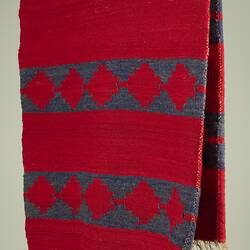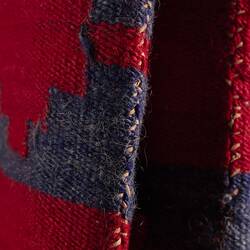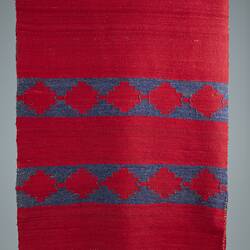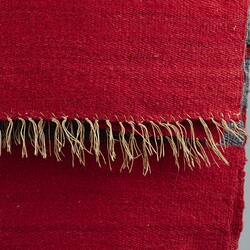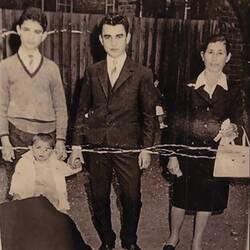Summary
Hand-woven blanket created by Efstathia (Effie) Spiropoulos who migrated to Melbourne with her husband and seven children from Greece on the Patris in 1964. The blanket is red with blue stripes and geometric shapes.
Efstathia Angelopoulos was born in 1920 in Flessiada on the outskirts of Kalamata in the Peloponnese, Greece. Effie made the blanket around 1938-39 as part of her dowry (prika) when she was about 19 years old. She made it from scratch, shearing the sheep, washing and drying the wool, carding and spinning the wool into yarn, dyeing it and weaving the blanket on a loom (aryalio).
The blanket was amongst several items woven by Efstathia and was kept as a precious family heirloom and unlikely used. This collection also include digital photographs of Efstathia and her family.
Physical Description
Red blanket made from sheep's wool, hand-carded, spun and dyed. The patterns consist of four blue segments each 18cm wide, two on each end of the blanket running the width of the blanket. The short ends are fringed. There are red geometric shapes within the blue segments, five shapes on each panel making a total of ten geometric shapes matching perfectly across its width in all of the four blue segments. The blanket was woven on a wooden loom in two identical panels the width of the loom and then joined with great precision to align the patterns and make it large enough for a blanket. Each panel is approximately 87cm and once joined it is 174cm wide and 210cm in length.
Significance
This blanket beautifully documents the transporting of cultural traditions and related material culture through the act of migration. This blanket is unique in the collection for the detailed recording of how it was made, literally from the shearing of the sheep right through to the finished item. It is a precious memory object and a family heirloom steeped in connections back to homeland while representing the embracing of a new life in Australia.
The Museum holds a significant collection relating to Greek migration, settlement and cultural life in Victoria, which includes some Greek textiles - hand-made regional costumes and dowry items including a blanket. This blanket however, comes with an extremely well-documented story, with the provenance in tact and accompanying photographs. The blanket also compliments the museums collection relating to women's work in the making and acquiring of items for their glory box (trousseau or dowry).
More Information
-
Collecting Areas
Migration & Cultural Diversity, Clothing & Textiles, Home & Community, Working Life & Trades
-
Maker
-
Classification
-
Category
-
Discipline
-
Type of item
-
Object Dimensions
1740 mm (Width), 2100 mm (Height)
-
Keywords
Greek Immigration, Greek Communities, Greek Textiles, Handcrafts, Weaving, Artistic Practices, Crafts, Women's Work, Dowries, Looms

